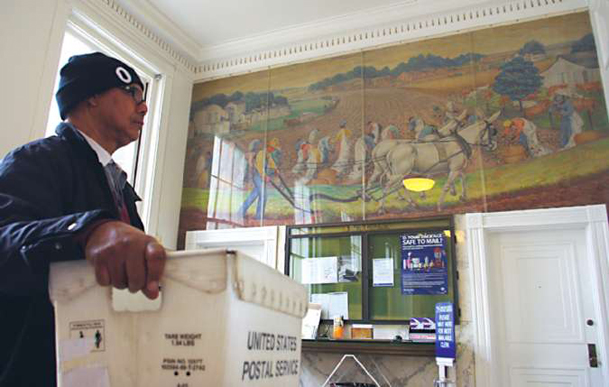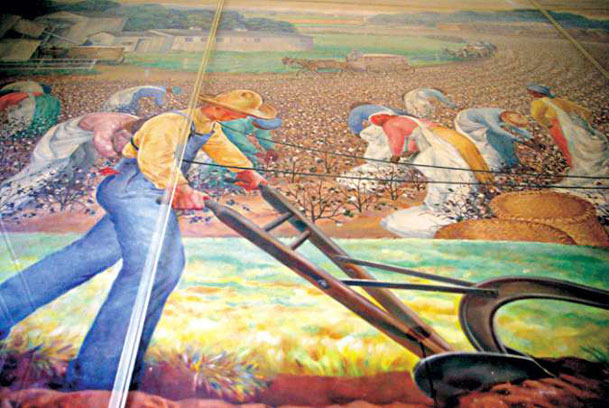It was 1939. Beulah Bettersworth of New York was in Columbus, taking in the scenery, for inspiration for her next work of art.
The artist had been commissioned by the federal government”s Section of Fine Arts to paint a mural to be installed at the downtown Columbus post office. Like its better known cousin, the Works Progress Administration, the Section of Fine Arts was part of the Depression-era effort to get the country back to work during the financial crisis of the 1930s.
After reviewing four submissions for the Columbus mural, the agency chose a scene with black field hands picking cotton. In the foreground, a white man is guiding a mule-powered plow. In the background are a church, cotton gin and lumber mill.
Many people have passed in and out of the post office for years without even noticing the mural. But it has the full attention of Ira Lanier, a native of Columbus who now lives in Colorado. Lanier has launched a one-man campaign to remove the historic mural, denouncing it as racist.
”Out of the Soil”
“Out of the Soil” was one of around 1,000 murals and paintings produced through the Section of Fine Arts, created in 1934, as the country struggled through the Great Depression. The agency commissioned work for post offices throughout the country.
The program was separate from the Works Progress Administration, established in 1935, which also commissioned artists and was much more far-reaching, creating more than 5,000 jobs for artists and producing more than 225,000 works of art, according to wpamurals.com.
Lanier has written to the postmaster general in Washington, the executive director of the American Civil Liberties Union, The Dispatch, a consumer advocate in Washington, the Southern Poverty Law Center and Columbus City Councilman Gene Taylor in an effort to remove the work.
On a trip to Columbus last July, Lanier said his heart ached because of the painting”s “statement” of “bigotry and exploitation.”
“In my wildest dreams, I can not envision that the sentiment and approval of blacks were considered, despite the overwhelming presence of blacks in the majority of these murals distributed throughout the South,” the letter reads.
Other than a “generic” letter of acknowledgment from the U.S. Post Office in Washington, Lanier said he hasn”t gotten a response from his letters.
Lanier, who graduated from Hunt (then an all-black school) in 1958, proposes showing the piece at the public library or Mississippi University for Women during Black History Month or housing it at a black-history museum, rather than at the public post office where it invokes “painful memories” of “racial intolerance.”
“In Columbus, I think there”s a wonderful story to be told of that era,” Lanier said over the phone Friday. But the post office, he said, is not the place for the mural.
”That”s our heritage”
Of the handful of patrons polled at the post office Friday morning, most found the setting a historically accurate depiction of the rural Mississippi of the time. Some had passed through the post office without ever noticing the nearly 16-foot-wide mural.
Annie Jeffries, a lifelong Mississippi resident, looked at the painting for the first time on Friday.
“It”s very nice,” she said. “It shows where we came from — how we all had to struggle to be able to survive. I know about that because I grew up here. It”s my home. We did such as that; we picked cotton.”
“That”s old-school Mississippi,” said Shey Jenkins, looking up at the mural. “That”s our heritage.”
“It”s what they do and still do around here — grow cotton, as I understand,” said Cliff Johnson.
Jenkins, who is white, said she “could see how it could offend some people,” but said it”s “not necessarily” racist.
“I see black faces, and I see cotton. Picking cotton. To me, it is (racist),” said Doris Payton, who is black.
But Payton admits, because of experiences over the years, she looks at things differently.
“That”s what I look at when I see things like this — to see what we (black people) are doing (in the pictures),” Payton said.
“When I look at it, it”s farming,” said Johnson, who is white. “It”s something that”s a large part of this area – the agricultural industry.”
In 1939, it was an even larger part of the area.
“People don”t realize, at one point, Mississippi was rural, rural, rural,” said postal worker Henry Mixon, who has worked at the post office since 1985.
Mixon, who is white, sees the painting as an artist”s rendering of what she saw during her stay in Columbus.
“There”s a white guy plowing. Looks like to me, they”re all working together to get the crop in,” he said.
When Mixon was growing up, his grandfather grew cotton in Vernon, Ala. “That was just part of it,” he said. “They hired field hands when they needed help.”
”Lots of blacks offended”
Bettersworth, originally from St. Louis, Mo., wrote on April 12, 1940, that her mural was hung “amid universal applause.”
“It was really thrilling to see and hear the response of an audience so appreciative!” she wrote.
The letter was scrawled on Gilmer Inn stationery to Edward Rowan, then assistant chief of the Section of Fine Arts, an office of the Public Buildings Administration, Federal Works Agency.
The post office has that letter and documents from the era on file, including an unnamed note about the mural, possibly written by the local postmaster at the time the artwork was delivered. “Lots of blacks offended,” the note mentions.
The unnamed reviewer also points out the mural isn”t perfect. The mule in the painting, for example, has a cow”s tail, and the plowman”s harness isn”t exactly right. Still, the note says the work was “pretty good for a Yankee woman who never saw the South end of a northbound mule.”
Another criticism is there are too many field hands picking cotton in one place. “They would have been spread out throughout the field,” Mixon noted Friday.
“If you look, most of the ones picking cotton are ladies, and that woulda been historically accurate, too,” Mixon offered. “The men did what they called harder work — carrying cotton bails and whatnot,” Mixon said, noting he had picked cotton in his younger days.
“I wouldn”t call that easy work,” he said.
In the last 20 years, Plexiglas has been put over the painting, on which Bettersworth did not put varnish.
“Almost all post offices had these murals, but they got tore down, burned down,” Mixon said.
Just prior starting work on “Out of the Soil,” Bettersworth completed a mural for the Indianola post office titled “White Gold in the Delta,” which also depicted workers in a cotton field. The paintings were done in oil on canvas and affixed to the walls.
The Indianola painting has since been destroyed.
Despite Lanier”s objections to the piece, and mixed reactions to the mural by post office customers on Friday, all agreed the historic mural depicts a time that is long past, but shouldn”t be forgotten.
“I don”t (see it as racist) because we all had to do it in order to survive — not just the blacks. I see nothing racist about it,” said Jeffries, who is black. “People leave (the South) and want to change certain things, but you can”t forget that part because it”s a part of your life. That”s your beginning.”
You can help your community
Quality, in-depth journalism is essential to a healthy community. The Dispatch brings you the most complete reporting and insightful commentary in the Golden Triangle, but we need your help to continue our efforts. In the past week, our reporters have posted 32 articles to cdispatch.com. Please consider subscribing to our website for only $2.30 per week to help support local journalism and our community.








